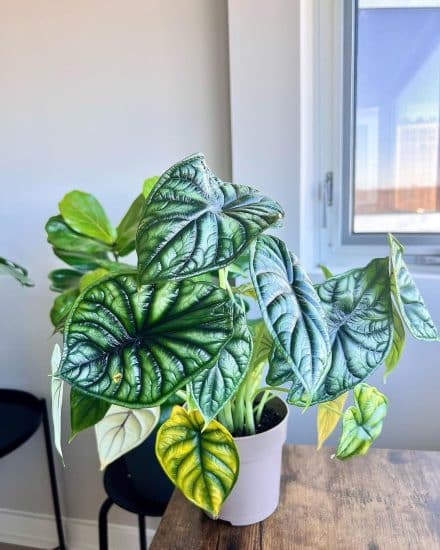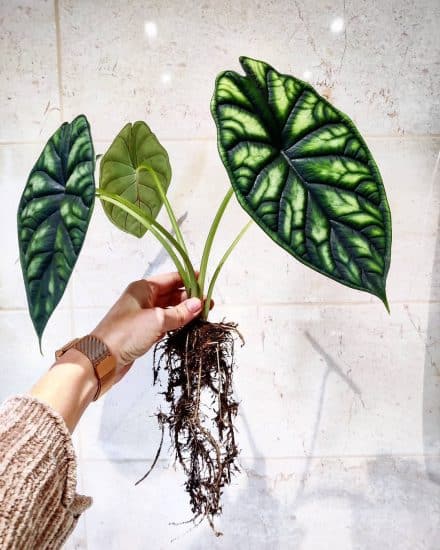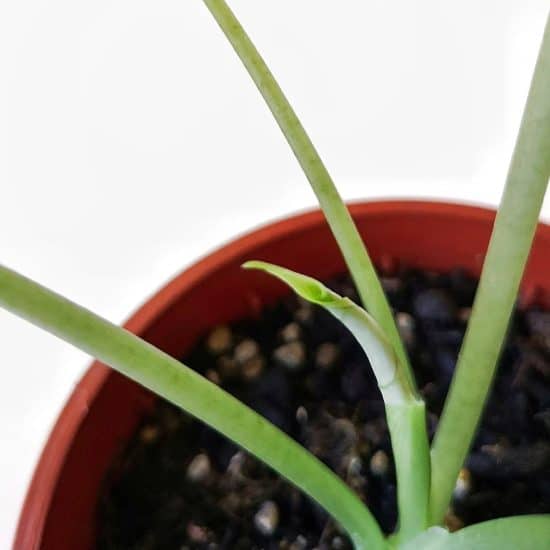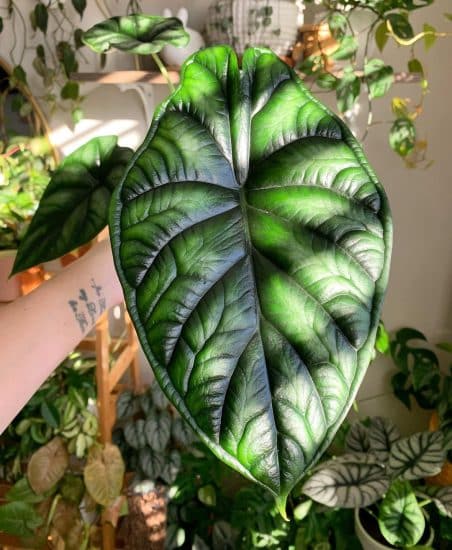If your houseplant collection is in need of some mythology and magic, look no further than the enchanting and exotic Alocasia Dragon Scale.
Alocasia Dragon Scale, much like its name suggests, boasts leaves with an intricate and textured pattern reminiscent of — you guessed it — dragon scales!
We’ll dive deep into the fantastic world of Dragon Scale Alocasia care, sharing everything you need to know about tending to this tropical plant. Whether you’re a seasoned green thumb or just dipping your toes into houseplant collecting, we’ve got your back.
Table of Contents
Alocasia Dragon Scale Plant Care Guide
History, Habitat, and Characteristics

Alocasia Dragon Scale (Alocasia baginda ‘Dragon Scale’) hails from the tropical rain forests of Southeast Asia. This enchanting houseplant is known for its large, textured leaves that resemble the skin of a mythical dragon.
Alocasia baginda is a member of the Araceae family and the Alocasia genus, which includes popular species like Alocasia amazonica and Alocasia zebrina. What sets our scaly friend apart is its striking leaf design and coloration. Its soft leaves boast a dark-green shade, while its sister plant, the Alocasia baginda ‘Silver Dragon,’ flaunts a shimmering silver hue.

One of the Dragon Scale’s most alluring features is its thick, velvety leaves that seem to have been conjured up by a wizard. This texture not only adds visual appeal, but also acts as a natural pest repellent. Flip the leaf over and you’ll discover an intricate network of veins, adding depth and charm to the plant’s appearance.
In its natural habitat, the Dragon Scale Alocasia thrives in warm, humid conditions, basking in dappled light beneath the rainforest canopy. In its native habitat, it can really spread its wings and grow as big as 6 feet or more, but expect a captive Dragon Scale Alocasia to clock in at about 2-3 feet.
Light

When it comes to the lighting requirements for your Alocasia Dragon Scale, finding that sweet spot between too much and too little light is key. These tropical plants prefer moderate to high light levels, yet direct sunlight for extended periods is a big no-no — it’s akin to breathing fire on its striking leaves.
To ensure your Alocasia Dragon Scale flourishes, provide filtered sunlight throughout the day or place it near a sunny window where it can bask in bright but indirect light. An east-facing window might just be the perfect location for this beauty, allowing it to soak up gentle morning sun without wilting under the harsh afternoon rays.
Our lighting tips:
- Provide bright, indirect light.
- Keep your dragon scale plant out of direct sunlight for extended periods.
- If your Alocasia Dragon Scale needs more light, you might notice sluggish growth and leaves yearning for a brighter spot.
Water

Understanding Alocasia Dragon Scale’s unique water requirements is key to a healthy plant. Dragon scale doesn’t like to dry out completely, so water when only the top 2 inches of soil has gone dry. Still, like many plants, it’s vulnerable to overwatering.
If your Alocasia Dragon Scale plant isn’t getting enough water, the leaves may start to wilt and droop. Underwatered plants can struggle to maintain their stunning appearance, and their health may suffer as a result. To avoid underwatering, monitor the soil’s moisture level and adjust your watering frequency accordingly.
Conversely, overwatering your Alocasia Dragon Scale can lead to its own set of problems. Overwatered plants may also show signs of damaged foliage, especially yellow leaves. Make sure you’re allowing the top few inches of soil to dry out before watering.
Our tips:
- To check soil moisture, insert your finger about an inch or two deep. If the soil is dry, it’s time to water.
- Use a well-draining pot to avoid waterlogged soil and damaged plant’s roots.
- Water less in the winter when the plant goes semi-dormant.
Temperature and Humidity

Alocasia plants have a reputation for having pretty picky humidity requirements. In this section, we’ll teach you how to strike the right balance of both temperature and humidity to keep your alocasia happy.
The perfect temperature range for your Alocasia Dragon Scale is a cozy 65-80°F (18-27°C). Beware of hot or cold drafts, which can stress your plant. Yellowing or wilted leaves might indicate that the temperature is too low, while brown tips or a dried-out appearance mean it’s too hot.
Alocasia Dragon Scale plants thrive in high humidity levels, ideally around 60%-80%, but they can also adapt to typical household humidity levels. Just keep an eye on your plant and add humidity if it looks sad. Crispy, brown leaf edges or drooping leaves are signs of too little humidity, whereas soft leaves and mold or fungus could mean excessive humidity.
Our tips to raise humidity:
- Set your Alocasia Dragon Scale on a pebble tray with water, allowing the evaporating water to create a moist atmosphere around the plant.
- Position a humidifier close to your plant, particularly during drier months.
- Cluster your Alocasia Dragon Scale with other plants to cultivate a more humid microclimate.
Soil and Planting

Alocasia baginda ‘Dragon Scale’ thrives in well-draining, nutritious soil. It also likes things slightly alkaline, which you can achieve by mixing compost or eggshells in with its well-draining soil.
Keep your Dragon Scale in the nursery pot for about a year — it actually prefers to be slightly root bound. When it’s ready, repot it in a slightly larger one. Ensure the new pot has drainage holes to prevent overwatering and potential root rot issues.
Plastic pots are best for your Alocasia Dragon Scale because ceramic pots may retain excessive moisture and foster mold growth. Terracotta pots, on the other hand, tend to be a bit too porous for this plant, making it difficult to keep enough moisture.
Ensure your Alocasia Dragon Scale flourishes by crafting a chunky, well-draining potting mix containing perlite, pumice, and orchid bark. Add coconut coir to retain moisture without drowning the roots. These elements together provide aeration, prevent compaction, and promote healthy root development.
Fertilizing

Alocasia Dragon Scale plants are heavy feeders that need nutrient-rich fertilizer to remain healthy. Feed them a houseplant fertilizer during the growing season. To give your Alocasia Dragon Scale a nutritional boost, add calcium supplements like Cal-Mag to your fertilizer routine.
Monitor for signs of over-fertilizing, such as yellowing leaves or brown leaf tips. If you notice these symptoms, flush the soil by running water through it for several minutes to leach out excess salts. Then, reduce the fertilizer application and watch your plant’s response to ensure it returns to its vibrant state.
Propagation

Alocasia likes to be repotted yearly in spring. This is a great time to divide the mature plant for propagation! The best method for Alocasia Dragon Scale propagation is through corm division.
- Gather your materials: Before you start, make sure you have everything you need. Grab fresh potting mix with added perlite and a small pot or container.
- Find the corms: Gently take your Alocasia Dragon Scale out of its pot and check the soil around the roots. You’re looking for small corms, tiny bulb-like structures.
- Carefully separate the corms: Now, go ahead and gently twist the corms away from the mother plant, making sure not to damage any part of the root system. Clean off any leftover soil from the corm.
- Place the corm in a growing medium: Moisten a bit of coconut coir or perlite and place the separated corms in it. Keep the growing medium damp, but not soaking wet.
- Wait for new growth: Put the corms in a warm spot with bright light, but avoid direct sun for the best results. Keep an eye out for a new leaf sprouting from the corm – it might take a few weeks to a month.
- Time to pot the new plant: Once your corms have sprouted new growth, your baby Alocasia Dragon Scales are ready for their own pots. Plant them in fresh potting mix, making sure the corms are covered but the new growth is not, and then give your new plants the same love and care as the mother plant.
Common Issues

Alocasia Dragon Scale plants can be a bit sensitive when young, but with attentive care, they grow into resilient beauties that flourish indoors. To keep your alocasia thriving, it’s important to recognize and address the most common issues.
Yellow Leaves

Yellow curling leaves on your Alocasia baginda may indicate overwatering or insufficient nutrients. First, check the top two inches of your plant’s soil for moisture. If it’s wet, adjust your watering schedule to allow the soil to dry out between waterings, and make sure the pot drains well to avoid standing water.
If the issue continues, try using a balanced liquid fertilizer to provide the necessary nutrients.
When yellow leaves also show crisping or browning edges, it often means inadequate humidity or excessive direct sunlight. To create the perfect environment, position your plant in a spot with filtered sunlight through a sheer curtain, and boost humidity with a humidifier or water-filled pebble tray nearby.
Dropping Leaves
Dying leaves dropping from your Alocasia Dragon Scale could signal temperature fluctuations, improper lighting, or watering issues. First, ensure the plant stays within the ideal temperature range of 65-80°F (18-27°C), avoiding cold drafts or sudden changes that could stress it.
Next, assess your plant’s lighting. Alocasia Dragon Scale plants thrive in filtered sunlight, so move it closer to a window with indirect light or supplement with grow lights.
Finally, evaluate your watering habits, because both overwatering and underwatering can lead to dropping leaves. Strive for a balanced watering routine by allowing the top 2 inches of soil to dry out between waterings and ensuring proper drainage.
Pests and Diseases

Alocasia Dragon Scale is a resilient houseplant, with thick leaves providing natural protection against common houseplant pests and diseases. However, even the sturdiest plant can face problems like wet soil issues, fungus, and bug infestations.
Leaf Spot Diseases
Fungal problems like leaf spot can arise when there’s too much moisture in your plant’s environment. Be on the lookout for fuzzy or discolored spots on leaves and stems. If you find any, remove the affected leaves and treat the plant with a fungicide.
To stop leaf spot from coming back, it’s crucial to maintain good air circulation and proper watering habits. This means avoiding overwatering and ensuring no water sits on the leaves for too long.
Pests
Although the Alocasia Dragon Scale’s thick leaves make it less attractive to pests, it’s still vulnerable to spider mites and mealybugs. These pests typically hide on the undersides of leaves, causing observable damage and yellowing.
Spider mites are easily diagnosable by checking for webbing on the leaves or tiny moving specks. Mealybugs, on the other hand, look like thin layers of cotton on the leaves and stems of your plant.
If you find either of these, isolate the affected plant and wash the leaves thoroughly with soapy water. A small cloth or cotton ball may come in handy.
Next, apply insecticidal soap or neem oil, coating the entire plant, especially the undersides of leaves. Keep treating as directed until the infestation disappears. Keep your plant out of extreme temperatures or sunlight while you’re treating it, to avoid shock.
Conclusion

That’s it for our Dragon Scale Alocasia care guide!
With its enchanting, scale-like leaves and captivating appearance, Alocasia Dragon Scale is truly a gem in the world of houseplants. By following our comprehensive guide, you’ll be well equipped to care for this tropical beauty and enjoy its stunning presence in your home.
Alocasia Dragon Scale care summary:
- Provide filtered sunlight or bright, indirect light, and keep your plant out of excessive direct sunlight to prevent leaf scorching.
- Maintain a consistent watering schedule, allowing the top 2 inches of soil to dry out between waterings.
- Select a well-draining potting mix with perlite, pumice, and orchid bark, and choose a pot with drainage holes to prevent standing water and root rot.
- Maintain a comfortable temperature range of 65-80°F (18-27°C) and provide high humidity levels, though the plant can adapt to lower household humidity if needed.
- Propagate your Dragon Scale Alocasia through corm division during its growing season.
We hope this guide proves an invaluable resource as you embark on your Dragon Scale Alocasia journey. If you have any questions or need further assistance, don’t hesitate to reach out. And, of course, feel free to share this guide with fellow plant lovers!
FAQ
What’s the difference between Alocasia Dragon Scale and Alocasia Silver Dragon?
Alocasia Dragon Scale and Alocasia Silver Dragon are distinct varieties of alocasia. Dragon Scale boasts velvety, dark-green leaves adorned with intricate, vein-like patterns that resemble the captivating scales of a mythical dragon.
Alocasia Silver Dragon features silvery-green leaves with contrasting dark green veins. This variety showcases a shimmery, metallic sheen on its foliage, creating a delicate visual appeal.
Is there a variegated Alocasia Dragon Scale?
No. While variegated plant varieties often make popular and captivating additions to any collection, there is currently no known variegated version of the Alocasia Dragon Scale.
Is Alocasia Dragon Scale rare?
Alocasia Dragon Scale, while not exceptionally rare, is considered relatively uncommon compared to other more widely available alocasia cultivars. This stunning houseplant has gained popularity among enthusiasts for its unique and eye-catching foliage. As a result, it can sometimes be challenging to find in local nurseries or garden centers.


